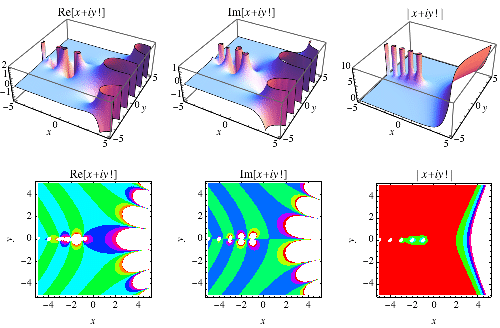阶乘 对于正整数
定义为
|
(1)
|
因此,例如,。较旧的阶乘记号写作
(Mellin 1909; Lewin 1958, p. 19; Dudeney 1970; Gardner 1978; Conway and Guy 1996)。
特殊情况 被定义为值
,这与恰好一个排列零个对象的组合解释一致(即,零个元素的排列只有一个,即空集
)。
阶乘在 Wolfram 语言中实现为阶乘[n] 或 n!。
三角形数 可以被看作是阶乘
的加法模拟。阶乘和三角形数之间的另一个关系由以下恒等式给出
 |
(2)
|
(K. MacMillan,私人通信,1 月 21 日,2008 年)。
阶乘 给出了
个对象可以排列的方式的数量。例如,
,因为
的六种可能的排列是
、
、
、
、
、
。对于
、1、2、...,前几个阶乘是 1、1、2、6、24、120、... (OEIS A000142)。
对于 、1、...,
中的位数是 1、7、158、2568、35660、456574、5565709、65657060、... (OEIS A061010)。
可以定义阶乘的推广,例如双阶乘 和多阶乘
。但是请注意,这些不等于嵌套阶乘
、
等。
对于 、2、...,
的前几个值是 1、2、720、620448401733239439360000、... (Eureka 1974; OEIS A000197)。
中的位数是 1、1、3、24、199、1747、... (OEIS A063979)。
当 变大时,阶乘开始出现尾随零。要计算
的尾随零的数量
,请使用
 |
(3)
|
其中
|
(4)
|
且 是向下取整函数 (Gardner 1978, p. 63; Ogilvy and Anderson 1988, pp. 112-114)。对于
、2、...,尾随零的数量是 0、0、0、0、1、1、1、1、1、2、2、2、2、2、3、3、... (OEIS A027868)。这是勒让德在 1808 年首次发现的一般结果的特殊应用:整除
的素数
的最大幂是
 |
(5)
|
(Landau 1974, pp. 75-76; Honsberger 1976; Hardy and Wright 1979, pp. 342; Ribenboim 1989; Ingham 1990, p. 20; Graham et al. 1994; Vardi 1991; Hardy 1999, pp. 18 and 21; Havil 2003, p. 165; Boros and Moll 2004, p. 5)。这可以在 Wolfram 语言中实现为
HighestPower[p_?PrimeQ, n_] :=
Sum[Floor[n/p^k], {k, Floor[Log[p,n]]}]
|
(6)
|
其中 是
在
进制下的数字和 (Boros and Moll 2004, p. 6)。这可以在 Wolfram 语言中实现为
HighestPower2[p_Integer?PrimeQ, n_] :=
(n - Total[IntegerDigits[n, p]])/(p - 1)
因此,正如勒让德所示,
|
(7)
|
(Havil 2003, p. 165)。
设 为
中的最后一个非零数字,则前几个值是 2、6、4、2、2、4、2、8、8、8、6、8、... (OEIS A008904)。Kakutani (1967) 研究了这个序列,他表明这个序列是“5-自动的”,大致意思是存在一个有限自动机,当给定
在 5 进制下的数字时,它将最终进入一个状态,该状态的输出映射指定
。数字的精确分布由此结果得出。
 |
通过注意到
|
(8)
|
|
(9)
|
这定义了所有复数值 的
,除非
是负整数,在这种情况下,
等于复无穷大。
虽然高斯 (G1) 引入了记号
|
(10)
|
但在勒让德引入伽玛记号后,此记号随后被弃用 (Edwards 2001, p. 8)。
使用伽玛函数的恒等式,(半整数值)的值可以显式写出
|
(11)
| |||
|
(12)
| |||
|
(13)
| |||
|
(14)
|
其中 是双阶乘。
对于整数 和
,且
,
|
(15)
|
的对数经常遇到
|
(16)
| |||
![1/2ln[(piz)/(sin(piz))]-1/2ln((1+z)/(1-z))+(1-gamma)z-sum_(n=1)^(infty)[zeta(2n+1)-1](z^(2n+1))/(2n+1)](/images/equations/Factorial/Inline74.svg) |
(17)
| ||
|
(18)
| |||
|
(19)
| |||
|
(20)
|
其中 是欧拉-马歇罗尼常数,
是黎曼 zeta 函数,而
是多伽玛函数。
它也由极限给出
|
(21)
| |||
|
(22)
| |||
|
(23)
| |||
|
(24)
|
其中 是波赫哈默尔符号。
其中 是欧拉-马歇罗尼常数,
是黎曼 zeta 函数,而
是多伽玛函数。阶乘可以展开为级数
|
(25)
|
(OEIS A001163 和 A001164)。斯特林级数给出了 的级数展开
|
(26)
| |||
|
(27)
|
(OEIS A046968 和 A046969),其中 是伯努利数。
一般来说,幂乘积序列 (Mudge 1997) 由 给出。
的前几项是 2、5、37、577、14401、518401、... (OEIS A020549),并且对于
、2、3、4、5、9、10、11、13、24、65、76、...,
是素数 (OEIS A046029)。
的前几项是 0、3、35、575、14399、518399、... (OEIS A046032),但
仅对于
是素数,因为对于
,
。
的前几项是 0、7、215、13823、1727999、... (OEIS A046033),而
的前几项是 2、9、217、13825、1728001、... (OEIS A019514)。
前几个数 ,使得其数字的阶乘之和等于素数计数函数
是 6500、6501、6510、6511、6521、12066、50372、... (OEIS A049529)。此序列是有限的,最大项是
。
满足以下条件的数 被称为威尔逊素数。
|
(28)
|
被称为威尔逊素数。
|
(29)
|
仅已知三对这样的数:(5, 4), (11, 5), (71, 7)。Erdős 猜想这仅有的三个这样的对 (Guy 1994, p. 193)。